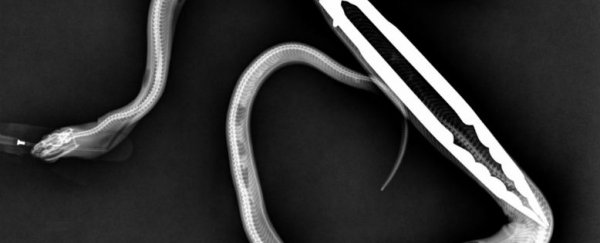A pet python has undergone surgery in Adelaide, South Australia to remove the pair of BBQ tongs that were lodged inside him. The snake - a two-year-old Woma python (Aspidites ramsayi) called Winston - was being fed a rat by his owner using the metal tongs. He latched on and refused to let go. "I tried to prise him off the tongs but we didn't have any hope of that at all," his owner, Aaron Rouse, told 891 ABC Adelaide.
He left the python to play with them, returning later to find Winston had gobbled them up. "I was dumfounded."
Woma pythons are native to southwest Queensland, central and western Australia, and this one was presented in a box to veterinary surgeon, Oliver Funnell, at the Companion Animal Health Centre at the University of Adelaide, after a very uncomfortable meal. Initially, Funnell thought they were dealing with a small pair of forceps or tweezers. "I asked Aaron if he was sure that the snake had swallowed the tongs," he told ScienceAlert. "From Aaron's reaction I could tell that I was about to see something unusual."
Funnell says the skin and muscles were so tightly constricted around the tongs that you could make out its structure. "Through the skin you could feel the bumps on the end of the tongs and at the other end the relatively square hinge could be seen obviously protruding through abdominal wound," he said. "These tongs have a small clip that can be moved up and down to lock them and this could be easily identified."
Snakes can swallow very large prey items because of their flexible lower jaws. In most animals, the lower jaw is fused but snakes have an elastic ligament which allows the mouth to stretch open very wide, says Funnell. "The snake will then engulf the prey or in this case the tongs using what has been called the 'pterygoid walk', where the teeth are ratcheted over the prey as it is pushed into the snakes gastrointestinal tract."
Funnell says that Winston grabbed the rat and tongs and quickly wrapped himself around them: "These animals even when small can be very strong."
Operating on Winston proved to be an exercise fraught with a number of challenges. The first was anesthetising him, as snakes are cold-blooded, which makes their drug metabolism slower. To combat this, the team used two anesthetics, allowing them to pass a catheter into Winston's trachea so he could breathe and be anesthetised throughout the operation.
Although some of the general principles apply, when surgery is performed on a snake, there are some important differences, says Funnell. One of these is that because a snake's ribs extend from most of the animal's vertebrae (rather than having a distinct rib-cage), "the location of the incision is important. The incision should ideally be made below the ribs so that they do not need to be cut… (and) between the scales and not through them," he said.
The team made an educated guesstimate that the tongs were lodged in the oesophagus and stomach, but they couldn't be sure. They cut open the snake at the larger end of the tongs so they could pull them out before sowing Winston up. "Skin closure is slightly different from mammals as the scaled skin tends to roll under," says Funnell.
After four weeks, Winston's stitches will be removed, but so far things are looking good. "At the follow up appointment, the snake was acting normally and had been seen drinking," said Funnell. He'll eat again in two to four weeks, and Funnell and Rouse are hoping he'll keep tongs out of his diet from now on.
 Credit: Oliver Funnell
Credit: Oliver Funnell
